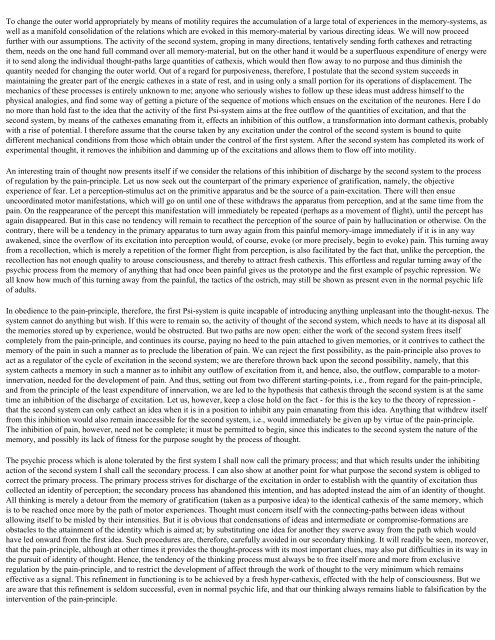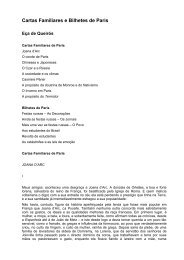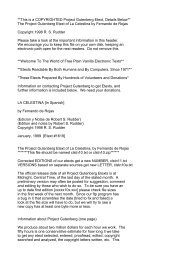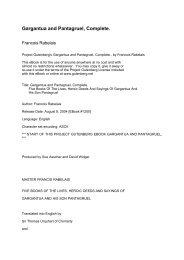The Interpretation of Dreams Sigmund Freud (1900)
The Interpretation of Dreams Sigmund Freud (1900)
The Interpretation of Dreams Sigmund Freud (1900)
Create successful ePaper yourself
Turn your PDF publications into a flip-book with our unique Google optimized e-Paper software.
To change the outer world appropriately by means <strong>of</strong> motility requires the accumulation <strong>of</strong> a large total <strong>of</strong> experiences in the memory-systems, as<br />
well as a manifold consolidation <strong>of</strong> the relations which are evoked in this memory-material by various directing ideas. We will now proceed<br />
further with our assumptions. <strong>The</strong> activity <strong>of</strong> the second system, groping in many directions, tentatively sending forth cathexes and retracting<br />
them, needs on the one hand full command over all memory-material, but on the other hand it would be a superfluous expenditure <strong>of</strong> energy were<br />
it to send along the individual thought-paths large quantities <strong>of</strong> cathexis, which would then flow away to no purpose and thus diminish the<br />
quantity needed for changing the outer world. Out <strong>of</strong> a regard for purposiveness, therefore, I postulate that the second system succeeds in<br />
maintaining the greater part <strong>of</strong> the energic cathexes in a state <strong>of</strong> rest, and in using only a small portion for its operations <strong>of</strong> displacement. <strong>The</strong><br />
mechanics <strong>of</strong> these processes is entirely unknown to me; anyone who seriously wishes to follow up these ideas must address himself to the<br />
physical analogies, and find some way <strong>of</strong> getting a picture <strong>of</strong> the sequence <strong>of</strong> motions which ensues on the excitation <strong>of</strong> the neurones. Here I do<br />
no more than hold fast to the idea that the activity <strong>of</strong> the first Psi-system aims at the free outflow <strong>of</strong> the quantities <strong>of</strong> excitation, and that the<br />
second system, by means <strong>of</strong> the cathexes emanating from it, effects an inhibition <strong>of</strong> this outflow, a transformation into dormant cathexis, probably<br />
with a rise <strong>of</strong> potential. I therefore assume that the course taken by any excitation under the control <strong>of</strong> the second system is bound to quite<br />
different mechanical conditions from those which obtain under the control <strong>of</strong> the first system. After the second system has completed its work <strong>of</strong><br />
experimental thought, it removes the inhibition and damming up <strong>of</strong> the excitations and allows them to flow <strong>of</strong>f into motility.<br />
An interesting train <strong>of</strong> thought now presents itself if we consider the relations <strong>of</strong> this inhibition <strong>of</strong> discharge by the second system to the process<br />
<strong>of</strong> regulation by the pain-principle. Let us now seek out the counterpart <strong>of</strong> the primary experience <strong>of</strong> gratification, namely, the objective<br />
experience <strong>of</strong> fear. Let a perception-stimulus act on the primitive apparatus and be the source <strong>of</strong> a pain-excitation. <strong>The</strong>re will then ensue<br />
uncoordinated motor manifestations, which will go on until one <strong>of</strong> these withdraws the apparatus from perception, and at the same time from the<br />
pain. On the reappearance <strong>of</strong> the percept this manifestation will immediately be repeated (perhaps as a movement <strong>of</strong> flight), until the percept has<br />
again disappeared. But in this case no tendency will remain to recathect the perception <strong>of</strong> the source <strong>of</strong> pain by hallucination or otherwise. On the<br />
contrary, there will be a tendency in the primary apparatus to turn away again from this painful memory-image immediately if it is in any way<br />
awakened, since the overflow <strong>of</strong> its excitation into perception would, <strong>of</strong> course, evoke (or more precisely, begin to evoke) pain. This turning away<br />
from a recollection, which is merely a repetition <strong>of</strong> the former flight from perception, is also facilitated by the fact that, unlike the perception, the<br />
recollection has not enough quality to arouse consciousness, and thereby to attract fresh cathexis. This effortless and regular turning away <strong>of</strong> the<br />
psychic process from the memory <strong>of</strong> anything that had once been painful gives us the prototype and the first example <strong>of</strong> psychic repression. We<br />
all know how much <strong>of</strong> this turning away from the painful, the tactics <strong>of</strong> the ostrich, may still be shown as present even in the normal psychic life<br />
<strong>of</strong> adults.<br />
In obedience to the pain-principle, therefore, the first Psi-system is quite incapable <strong>of</strong> introducing anything unpleasant into the thought-nexus. <strong>The</strong><br />
system cannot do anything but wish. If this were to remain so, the activity <strong>of</strong> thought <strong>of</strong> the second system, which needs to have at its disposal all<br />
the memories stored up by experience, would be obstructed. But two paths are now open: either the work <strong>of</strong> the second system frees itself<br />
completely from the pain-principle, and continues its course, paying no heed to the pain attached to given memories, or it contrives to cathect the<br />
memory <strong>of</strong> the pain in such a manner as to preclude the liberation <strong>of</strong> pain. We can reject the first possibility, as the pain-principle also proves to<br />
act as a regulator <strong>of</strong> the cycle <strong>of</strong> excitation in the second system; we are therefore thrown back upon the second possibility, namely, that this<br />
system cathects a memory in such a manner as to inhibit any outflow <strong>of</strong> excitation from it, and hence, also, the outflow, comparable to a motorinnervation,<br />
needed for the development <strong>of</strong> pain. And thus, setting out from two different starting-points, i.e., from regard for the pain-principle,<br />
and from the principle <strong>of</strong> the least expenditure <strong>of</strong> innervation, we are led to the hypothesis that cathexis through the second system is at the same<br />
time an inhibition <strong>of</strong> the discharge <strong>of</strong> excitation. Let us, however, keep a close hold on the fact - for this is the key to the theory <strong>of</strong> repression -<br />
that the second system can only cathect an idea when it is in a position to inhibit any pain emanating from this idea. Anything that withdrew itself<br />
from this inhibition would also remain inaccessible for the second system, i.e., would immediately be given up by virtue <strong>of</strong> the pain-principle.<br />
<strong>The</strong> inhibition <strong>of</strong> pain, however, need not be complete; it must be permitted to begin, since this indicates to the second system the nature <strong>of</strong> the<br />
memory, and possibly its lack <strong>of</strong> fitness for the purpose sought by the process <strong>of</strong> thought.<br />
<strong>The</strong> psychic process which is alone tolerated by the first system I shall now call the primary process; and that which results under the inhibiting<br />
action <strong>of</strong> the second system I shall call the secondary process. I can also show at another point for what purpose the second system is obliged to<br />
correct the primary process. <strong>The</strong> primary process strives for discharge <strong>of</strong> the excitation in order to establish with the quantity <strong>of</strong> excitation thus<br />
collected an identity <strong>of</strong> perception; the secondary process has abandoned this intention, and has adopted instead the aim <strong>of</strong> an identity <strong>of</strong> thought.<br />
All thinking is merely a detour from the memory <strong>of</strong> gratification (taken as a purposive idea) to the identical cathexis <strong>of</strong> the same memory, which<br />
is to be reached once more by the path <strong>of</strong> motor experiences. Thought must concern itself with the connecting-paths between ideas without<br />
allowing itself to be misled by their intensities. But it is obvious that condensations <strong>of</strong> ideas and intermediate or compromise-formations are<br />
obstacles to the attainment <strong>of</strong> the identity which is aimed at; by substituting one idea for another they swerve away from the path which would<br />
have led onward from the first idea. Such procedures are, therefore, carefully avoided in our secondary thinking. It will readily be seen, moreover,<br />
that the pain-principle, although at other times it provides the thought-process with its most important clues, may also put difficulties in its way in<br />
the pursuit <strong>of</strong> identity <strong>of</strong> thought. Hence, the tendency <strong>of</strong> the thinking process must always be to free itself more and more from exclusive<br />
regulation by the pain-principle, and to restrict the development <strong>of</strong> affect through the work <strong>of</strong> thought to the very minimum which remains<br />
effective as a signal. This refinement in functioning is to be achieved by a fresh hyper-cathexis, effected with the help <strong>of</strong> consciousness. But we<br />
are aware that this refinement is seldom successful, even in normal psychic life, and that our thinking always remains liable to falsification by the<br />
intervention <strong>of</strong> the pain-principle.









